Former Rock Island Argus Reporter Conquers D.C., Releases New Book on Miss America History
Saturday in the Arts is a weekly feature covering a trend, subject, event or personality of local interest. It runs every Saturday morning on  your site for the best entertainment and arts coverage in the area, QuadCities.com!
your site for the best entertainment and arts coverage in the area, QuadCities.com!
Reading the breezy, illuminating, insightful and downright fascinating new book, “There She Was: The Secret History of Miss America,” you can tell that author Amy Argetsinger gets it.
The 384-page book sings – on the 100th anniversary of the beauty competition (it is NOT a pageant anymore), the former Dispatch and Rock Island Argus reporter is a devoted fan and a chronicler of all that has gone right and wrong with Miss America, and she delivers that juicy history in a “just between us,” conversational style of a true BFF. And Argetsiner argues right from the introduction that supporters of the dreamlike national contest have had to fight for its relevance and importance over and over again.

A D.C. area native, Amy Argetsinger went to the University of Virginia and worked in the Quad-Cities from 1991 to 1995.
“How had this pop-culture relic of the 1920s survived so far past its natural shelf life?” she writes of Miss America’s collision with the late ‘60s feminist movement. “The answer seemed to lie with the women who competed for its crown, and the unexpected new energy that emerged in their ranks circa 1970.
“Coincidence? Hardly,” Argetsinger claims. “The women’s movement had set out to vanquish Miss America – and ended up accidentally resuscitating instead. The pageant evolved because young women in America had evolved.”
In its heyday, Miss America was viewed by tens of millions of people nationwide. From its giddy origins as a summer’s-end tourist draw in Prohibition-era Atlantic City, it blossomed into a cultural phenomenon with a national network. “For all of its pomp and kitsch, the Miss America pageant is indelibly written into the American story,” says the promo release for the Simon & Schuster book.
Argetsinger brings the hidden world of the iconic competition to life in this deeply reported journey through Miss America’s past and present, featuring interviews with dozens of the women who won or desperately sought the title.

Argetsinger has worked for the Washington Post since May 1995, including as an editor since 2014.
She explores how the dusty institution confronted a women’s liberation movement that sought to abolish it, and how it was reborn thanks to the new energy of baby boomer and Generation X contestants, through stories of both the superstars of Miss America—Gretchen Carlson, Vanessa Williams, Phyllis George—and those that never became household names. We meet Bette Cooper, who was so overwhelmed on winning Miss America that she ran away the night she was crowned. Carolyn Sapp, the accidental domestic violence crusader. And Miss America 2020 Camille Schrier, a pharmacy student who won the talent competition by demonstrating an explosive chemical reaction.
In a recent book excerpt in Time magazine on Carolyn Sapp of Hawaii, the Miss America 1992, Argetsiner observed:
“Miss America had never dealt with a Miss America quite like Carolyn Sapp before. She looked like an old-school beauty queen from the 1940s, an hourglass knockout with the big shoulders and the big face and big hair, her natural strawberry blonde dyed a rich mahogany to set off her pale skin and dark red lips. (It was the ’90s.) But her energy was a very new thing. She had a swingy kind of walk and eyes that would pin you to the wall while her mouth stayed in constant motion, laughing, talking, smiling.
“The night she was crowned, when they told her they needed a family picture, but just with your mom and dad, okay? Sapp pushed back, not for the last time, and got both her stepparents and her three half-siblings and a grandmother and a couple aunts and a cousin in the photo, too. The next morning, as she posed for photos in the surf, she let the Old English sheepdog who came bounding into the frame lick the makeup off her face, and the photographers nearly died of joy.”
What’s not to love about that attention to detail and affection for her subject? Lisa Birnbach gets that, in her review of “There She Was” in Argetsinger’s home newspaper (and employer since mid-1995), The Washington Post, on Sept. 8 (the book was released Sept. 7):
“Argetsinger, an editor of The Washington Post’s Style section, is a true pageant enthusiast; she brings empathy and respect to the women who have followed this path,” the review says, noting the author doesn’t apologize for her love of Miss America. Long before she began work on this book, she would go to Atlantic City with her pals to watch the festivities in person. “It’s fun. The road trip to the Jersey Shore, the hike down the Boardwalk in cocktail garb.” The part she and her friends really loved was figuring out who would win. She got pretty good at it.

The cover for “There She Was: The Secret History of Miss America.”
In “There She Was,” Argetsinger studies the taxonomy of Miss America pageants from the 1970s to the present, taking in the many small, local contests that lead up to the mother of them all, Birnbach wrote.
“These people were glamorous aliens to me. Not like anyone that I knew growing up in the late 1960s and early 1970s. We looked up to the pioneers of 20th-century women’s liberation,” she said. “Meanwhile in the parallel universe Argetsinger examines, young women our very same ages were moving up from tiny county beauty and talent contests to citywide contests, to regional competitions and onward to Miss States. They were honing their acts — the dance routines, the songs, the monologues and yes, the baton twirling.”
“All this will be fascinating to beauty (and scholarship) pageant devotees who are curious about the before, during and immediate afterward of a winner’s life. What was her talent? Did she actually finish college or law school after her reign? What was new to me was the plight of the organization and the people who clutched power within it,” Birnbach wrote.
“Assiduously researched and beautifully written, There She Was explores the pageant’s history, its small-town roots and its glamorous allure with engaging reporting, wry humor and affection,” wrote Robin Givhan,
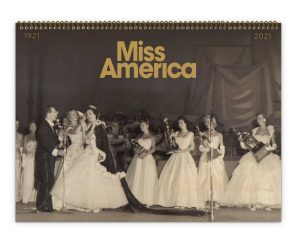
Miss America marks its 100th anniversary in 2021.
Pulitzer Prize-winning critic and Washington Post senior critic-at-large. “In Argetsinger’s capable hands, this is ultimately the story of women in this country.”
“In this wildly entertaining journey into an American institution we see how beauty is quantified and calibrated,” wrote Kate Andersen Brower, CNN contributor and New York Times bestselling author of The Residence, First Women and, most recently, Team of Five. “Surprisingly, some of the biggest disrupters, the people who want the crown to be about more than superficial beauty, are at the very heart of the country’s most celebrated beauty pageant. I couldn’t put this book down.”
Argetsinger also takes us behind the scenes to dissect the scandals and financial pressures that have repeatedly threatened to kill the pageant, including its most recent years of turmoil — the romance between a Miss America and pageant staffer that created rifts within the organization, the dysfunction revealed by the leak of the CEO’s private emails, the coup pulled off by a multigenerational crew of Miss Americas that long yearned for a greater role in running the pageant – and the civil war that erupted over Gretchen Carlson’s subsequent rise to the top of the organization.
She also reveals how the pageant whetted competitive instincts for generations of young women – nudging some into crash diets, fitness culture or plastic surgery – and became a venue for them to exercise their ambitions and learn brutal lessons about the culture of fame. We meet the coaches and mentors who could be just as competitive as their contestants, the winners who never really wanted to become Miss America, and those who planned their lives around it.
A Washington, D.C. native, a Q-C newbie
A 53-year-old native of the Washington, D.C. suburbs, Argetsinger went to the University of Virginia (where she didn’t major in journalism, but political thought), and started her journalism career in the Quad-Cities. She worked for the Dispatch/Argus in Rock Island from 1991 to May 1995.

Bettendorf native Emily Tinsman, left, and East Moline native Ariel Beverly competed in December 2019 as Miss Iowa and Miss Illinois.
“I covered health care. I covered the city of Silvis. I took a lot of general assignments, did a long stint working weekends. So I got to do a bit of everything,” she said in a recent phone interview. “It was a crazy experience and you know, I felt at the time that it was a pretty fortunate thing there was still an afternoon paper and that was already becoming kind of exotic at the time. There weren’t a lot of afternoon dailies left at that point, but what also made it such a great experience, was that it was a competitive market — that you actually had two newspapers going to head-to-head competition. There aren’t a lot of entry-level markets where you get that experience.”
Virginia didn’t have a journalism program then, and Argetsinger was editor of a campus alternative weekly, and fell in love with journalism.
“It’s fun, right?” she said. “I went to college thinking, maybe I’ll be an engineering major. But I discovered the student newspaper. Just to be in that newsroom environment, where you could be surrounded by information. I mean, I couldn’t get enough. This is before the internet and so to be in a newsroom, you suddenly have long exposure to wire services and news coming in, live across the wires and all of this reference and research material at your fingertips, or what seemed like our fingertips at the time. I mean, now anyone can get anything better on their phone, but it was just a really thrilling experience and never boring.”

Tinsman rocked a Miss Iowa mask during the Covid pandemic.
Argetsinger had never heard of the Q-C before moving here, and this is where she also first fell for the beauty pageant world.
“There was industrial and agricultural, that was very different from my surroundings, to live on the Mississippi River and go out and see the locks and dams — I found that incredibly thrilling,” she said. “It was very exotic to me and fun to watch and kind of felt like it was putting me in touch with this great artery of transportation I had never thought about before. It’s where I became more aware of pageants. I had watched Miss America growing up, like everyone did. But then when I was in the Quad-Cities, suddenly it was much more of a first-hand thing. I never really knew people who did pageants when I was growing up.
“But in the Quad-Cities, there were suddenly in 1991 and 1992, there were local women who were placing in the top five in Miss America,” Argetsinger said. “I remember going to the Henry County Fair and would see the queen of the Henry County Fair running around in crown and sash going down the giant slide. It was really cute. And it’s the first time I realized that the women that you see on TV, that they’re basically just younger than my age, but that they were real people. That there wasn’t anything particularly gilded or fancy about them. And they were just these young women who had kind of leaned into it and decided to do this thing.”
Since 1991, there have been eight Q-C women who won Miss Iowa, and competed for Miss America (the most recent, Bettendorf’s Emily Tinsman served two years, until June 2021). Argetsinger first saw the 1996 Miss America in person, when Davenport’s Natasha Courter competed as Miss Iowa.
“It was so much fun. It just opened my eyes to this crazy, the subculture of pageant fans,” she said. “And I went back several times after that.”
While Davenport’s Adler Theatre has long hosted the Miss Iowa competition, Argetsinger said she regretted never seeing it in person there. She was able to move from the Argus straight to The Washington Post (home of the legendary Woodward and Bernstein) due to hard work

Tinsman, a 2015 Bettendorf High alum, at the Miss America Competition in 2019.
and a good bit of luck.
“It was a bit of a magic moment,” she recalled. “The Washington Post, probably like some other newspapers, was looking around at its staff and realizing that they had too many people who were over 40 and that diversity was going to include having some people who are under 30. They were also at that point, really staffing up in a big way to try to cut off the outer ring suburbs. And in the mid-‘90s, they had a very dedicated program to bring experienced young journalists who could do those kinds of jobs, who would be willing and able to go out and cover county councils. It was a great expansion for The Post. And of course, The Post was the newspaper I grew up reading.
“It was the paper I’d always wanted to work for,” Argetsinger said. “I sent them a number of resumes over the years, but I did find when I called in for an interview that they were very impressed that I had gone to a market like the Quad-Cities and that I had done all the basic jobs in journalism because they very often heard from young people who wanted to go straight from college to a major metropolitan daily newspaper.
“And didn’t realize that there is a lot to be learned in smaller markets, a market like the Quad-Cities where really, I got out there at the age of 23, and I could do anything because it was a nurturing paper that let me do what I wanted and gave me a lot of opportunities and encouragement and (former editor) John Beydler in particular was always kind of coming up with out-of-the-box story ideas for me to pursue and a lot ended up being some of the clips that got me hired at The Washington Post.”
A ”wild ride” at The Post
In her first decade there, Argetsinger worked in the Annapolis bureau (the Maryland state capital and home to the U.S. Naval Academy), covered education in the region, and was Los Angeles bureau chief for a year, before taking over “The Reliable Source” column in 2005.
“It was essentially the gossip column, but with The Post’s very high standards, was a reported column. It wasn’t innuendo,” she said. “But it was covering personalities and celebrities and trying to break news of the personal lives of politicians and things like that, and that was a wild ride and a great learning experience.”

Camille Schrier of Virginia, was named Miss America 2020 and has served two years.
“I really had to learn how to be creative but also forward-thinking and be a better planner,” she said. “It put me into interesting rooms that honestly I never would have been in a million years — you know, elite parties and covering the Oscars and the White House Correspondents Dinner, stuff like that, that had really been very much outside my world.”
Argetsinger moved to become a Style section editor in 2014, after having a baby, and she occasionally contributes stories – including a moving tribute last October to a former Miss America, Leanza Cornett, who died at 49 after a head injury from a fall. Cornett, the 1993 title-holder, was the first to make AIDS awareness and prevention her platform.
“And honestly, editing for the Style section has been the best crash course in writing because working with all these great writers who combined are churning out all these remarkable long stories that need my ministrations,” Argetsinger said last month. “And I learned a lot about how to be a better writer, both by seeing what they do well, and learning from their pitfalls and just that incredible volume of helping craft these smart, sophisticated stories.”
While she did “The Reliable Source,” the Miss America program was coming back to life. “They had a new CEO who was very well-connected, who was really trying to get the Miss America name out there,” Argetsinger said. “You had some board members who were Washington people and they would bring the Miss Americas to Washington and I met a number of them during those. That was another demystifying experience because before then, I’d been watching the pageant, I’ve been going to the pageants with my friends and we would wager on who was going to be the winner.”
“Year after year, we would be wrong. We would never pick the winner correctly and it became this challenge,” she said. “Like what are we
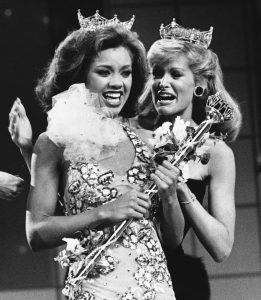
Vanessa Williams, the new Miss America, left, is shown as she is crowned, Saturday, Sept. 17, 1983 in Atlantic City, New Jersey, by the outgoing Miss America, Debra Maffett. (AP Photo)
missing here? What’s the X Factor? We kept thinking there’s a code or going to crack the code. We’re going to figure this out because I would always be surprised. Yet, once I met them in person, it was obvious. I think, oh, now I get it. That’s yes, of course she is clearly Miss America. You can tell me that moment she walks in the room and starts talking. Yes, she’s got it, whatever it is, she has it. And you don’t necessarily see that on TV. You don’t even see that if you’re in Atlantic City, watching a stage. So much of this is decided behind the scenes. And so that was kind of an added dynamic to try to factor.”
The first Miss America she met in person was Lauren Nelson (a Miss Oklahoma), who won in 2007, which Argetsinger saw in person with girlfriends in Las Vegas – among at least eight times she’s seen the contest in person.
“I remember Chris Matthews was one of the judges and I thought, this is a perfect item for my column,” she said. “I remember actually getting him on the phone while I’m in the airport on my way back home and asking him about his experience. And the Miss Texas who was really impressive and it was Lauren seemed like just a nice kid, and I remember asking him and like why her, why did she win? And he’s like, oh you just knew as soon as she walked in the room. She had this spark about her and, you know, I would hear people say that for years and like this isn’t helping me but sure enough. I’ve had that experience where I’ve met the Miss Americas and I can say oh, yeah, I guess she does have that spark.”
Miss America was held in Vegas or eight years, until 2013 when it returned to Atlantic City, but since 2018 it’s been held at the Mohegan Sun Casino and Resort in eastern Connecticut. For many decades, Miss America was run as a community project, Argetsinger said.
“They had a lot of local people who are running the organization who are on its board and they had a ton of local people who would volunteer for the pageant itself, to just run the whole show,” she said. “And there was a really a very special community feel about that. But there are just tensions because it wasn’t just this local thing. It was also an organization with big TV contracts that needed to maintain the service contract, and felt that it needed to make more connections in the larger world of entertainment and show business, and the character of the organization changed a lot. It’s probably had to do that, but it just definitely changed the dynamic.”
“Bye, bye bikinis!”
Another big change was the 2018 long-debated dropping of the swimsuit portion of the competition. “It was after the #MeToo movement had become such a big talking point in the culture. But I mean, it really goes back for nearly 50 years,” Argetsinger said. “The organization had been conflicted over the swimsuit competition, back in 1970, they were talking about whether they should get rid of it, even as they became more associated with scholarships, it was very hard for them to reconcile.

Phyllis George, 21-year-old Miss Texas, who became Miss America, pauses in sipping orange juices at her first breakfast as the nation’s new beauty queen, in Atlantic City, N.J., Sept. 13, 1970. (AP Photo/Bill Ingraham)
“Okay, we’re a scholarship organization that requires its competitors to go on stage in a bathing suit. What’s that about? When they made that change in 2018, my sense is that it was sort of a nuclear option reboot. They knew that the Miss America brand had really gone blurry, and a lot of people’s minds, they couldn’t tell the difference between Miss America and Honey Boo Boo and Miss USA and Miss Congeniality, but they’re all these stereotypes that even if the stereotypes are not true to the Miss America organization.”
“Dropping swimsuit was something that was meant to recalibrate the image in everyone’s mind and got some attention. And I think it was also out of a genuine discomfort with all of this,” she said. “The whole problem is that the community of people who are really dedicated to the pageant, who in many ways had kept it going for so many years. They were fine for the most part with swimsuits.”
Miss America underwent a major rift during the time when Gretchen Carlson (the 1989 Miss America) was chair, starting in January 2018, clashing with some board members who felt that they had been pressured into this change that perhaps was too rash, and that they worried that they were going to alienate so many volunteers, Argetsinger said.
“And that led to a power struggle that the organization really still hasn’t recovered from yet — just a huge exodus of board members and volunteers, a lot of lawsuits. It’s been, it’s been fairly ugly and it’s really a long-lasting scar on the organization. At a time when it was kind of weak to start with.”
“There was a lot of enthusiasm about her and her leadership in the beginning, because she really had become
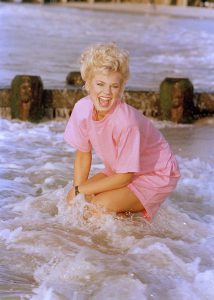
Gretchen Carlson of Anoka, Minn., who was crowned Miss America 1989 late Saturday, plays in the surf at Atlantic City, N.J., early Sept. 11, 1988 for the benefit of photographers. Carlson is the reigning Miss Minnesota. (AP Photo/Mike Derer)
the most prominent former Miss America and the Miss America community is very proud of a former Miss America,” she said. “Miss America kind of went from being a girl of the year to being what at least the pageant people thought of it — as woman of the future. They wanted very much for Miss America to be an award that recognizes someone’s potential to go out and do great things, and Gretchen Carlson had a very impressive career in broadcast news home and culminating in her epic lawsuit against Roger Ailes, that really led to the toppling of the founder of Fox News.
“You also saw the domino effect as many other women coming forward with their stories, not just about Roger Ailes, but as we saw all the accusations against Harvey Weinstein and many other powerful men,” Argetsinger said. “It was really the start of the #MeToo movement. And in a lot of ways, the community was very proud of her role in that. When it came to being the manager of this complicated non-profit organization that was affiliated with this huge network of grassroots organizations.
“And also trying to get on television year after year, she was considered much less of a success. There are some people who tried to blame her for the current state of disarray that the organization is in. I don’t think that’s quite fair. She inherited an organization that was not what it had been 20 years ago, let alone 40 years ago,” the author said. “But, you know, the marketplace has changed, the audience has changed even before she came along, the ratings had been dipping for so very long. It’s been harder to find what Miss America’s place is or should be in popular culture, and that’s something she was she was dealing with, but with the organization being in the fragile state it was, she was probably not the transformative manager and leader that they needed.”
“We will no longer judge our candidates on their outward physical appearance,” Carlson announced in June 2018, ushering in “Miss America 2.0,” declaring that the storied event is “no longer a pageant. We are a competition.” The contest started as a swimsuit pageant in Atlantic City in 1921, but the competition would no longer feature a swimsuit portion.
Social media users, including then-Miss America Cara Mund, used the hashtag #ByeByeBikini to show their support for the changes. Another controversy – according to Argetsinger — was simply the naming of the last winner, in December 2019 (the last Miss America), Virginia’s Camille Schrier, a doctoral student in the VCU School of Pharmacy.
“Her victory was very controversial within pageant circles because she did essentially a science experiment, a chemistry demonstration, instead of a traditional performing,” Argetsinger said. “A lot of her fellow competitors who felt like they were sort of shorted there, that they
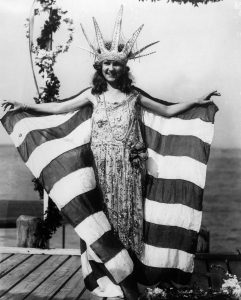
16-year-old Margaret Gorman won the first beauty pageant in Atlantic City in 1921, though it wasn’t called Miss America until the following year.
had played by the old rules and the old rules didn’t work anymore. Camille had a very impressive story. She had a story that was very much in line with what the organization wanted to tell. It wasn’t just that she had this earth science background and that she did an unconventional talent which got her a lot of media attention, which really matters right now. I’ll be honest, that matters.
“But she also had an interesting story and that she had never competed in the Miss America organization because she said, she didn’t feel comfortable with the swimsuit competition,” she said. “I saw a video tape of her interview and it was a very impressive interview, and you can tell that that was something that resonated with them. I think, even beyond me, that option of here’s a young woman who’s active in STEM, because they have a lot of competitors who are active in STEM.
“I think she had this very hopeful and optimistic narrative that she could offer to the Miss America pageant of, we’re on the right track,” Argetsinger said. “We’ve got rid of the swimsuit competition. And now finally, we have these dazzling, young women like Camille Schrier who are now going to step up and compete for our title. And they found out a great validation of what they’re trying to do, as they try to find their way in the 21st century. “The truth is that the number of women who compete with the local and state pageants has been dipping for years,” she said. “And my sense is that those numbers have continued to plummet just in the past three or four years of chaos within this organization. It’s hard for me to see how the lever gets back the kind of numbers that really made this such a pop culture landmark — this institution that had tentacles into communities across the country. It just does not have that choice anymore.”
Recent Q-C connections for Miss America
The first Miss America was crowned Sept. 8, 1921 – 16-year-old Margaret Gorman of Washington, D.C., though the competition was not renamed “Miss America” until she returned the following year.

Camille Schrier did a colorful science experiment during Miss America in December 2019.
The contest was originally an activity designed to attract tourists to extend their Labor Day holiday weekend and enjoy festivities in Atlantic City, N.J. Atlantic City’s Inter-City Beauty Contest, as it was initially called, attracted over 1,500 photographic entries from around the country, all vying to win the “Golden Mermaid” award and cash prizes.
Six “Inter-City Beauties,” arrived in Atlantic City and entered a new event: The “Inter-City Beauty” Contest. It was judged in stylish afternoon attire not only by the judges, but also the public, who accounted for 50 percent of the final score. Personality played a large role in the voting, as masses of people surrounded each entrant to get to know her better and throw questions at them throughout the event.
2020 was not the first year Miss America was not held (due to Covid); it also was scrapped from 1928 to 1932, during the Great Depression. While no Miss Iowa has ever won the crown, a Miss Illinois has triumphed five times – in 1927, 1969, 1991, 1998 and 2003. The last Illinois Miss America – Erika Harold, now 41 – unsuccessfully ran in 2018 as a Republican to become Illinois Attorney General.
In 2019, for the first time, the state pageants didn’t include a swimsuit competition. That part had previously contributed 10 percent of the

Emily Tinsman crowned Grace Lynn Keller the 2021 Miss Iowa at the Adler Theatre in June.
point total, so without it, there was more emphasis on the talent competition. The current categories are talent, interview, lifestyle/fitness, evening wear, and on-stage question.
The pageant is not focused on external beauty, and evening gowns also were eliminated as part of Miss America, Emily Tinsman of Bettendorf (crowned Miss Iowa in 2019) said. “You’ve seen a shift in attracting more types of women. Women who weigh more or look different, or feel they never could have had that opportunity, now have that option,” she said in an August 2019 interview. “There are talented people who thought, ‘I can’t walk around in a swimsuit; I can’t do that.’ It’s really cool to see that.”
“Even ethnicity — Miss America, you think she’s this tall, skinny, blond girl. That’s completely shifted,” Tinsman said, noting Iowa was the first state to send an African-American competitor to the Miss America pageant, in the ’80s. The 2018 Miss Iowa, Rock Island native and University of Iowa graduate Mikhayla Hughes-Shaw, also is African-American.
The last Miss America competition, in December 2019, was the first to feature two Q-C women competing at the same time – Tinsman, a 2019 Drake University grad, and East Moline native Ariel Beverly, a 2017 Illinois State alum. They both had raising money and awareness for arts education as their platform, and they both sang in the talent competition.
“It’s a pretty big opportunity, when you compete for $50,000 in scholarships, on TV,” Tinsman (now a public-school music teacher in Des Moines) said. “That’s a pretty intimidating thing to do. I was definitely nervous. I wasn’t as worried about my talent, just because – knowing me, I practiced it a million times. I wasn’t going to go in there and not be confident and comfortable. You always get that sense of butterflies when it’s a big performance, even when you are ready for it.”
The Miss America Organization is one of the most recognizable household names in America working to empower young women through education and service. The group is comprised of 51 licensed state organizations, including all 50 states and the District of Columbia. Miss America candidates contribute tens of thousands of community service hours annually and have raised more than $17 million for Children’s Miracle Network Hospitals and Miss America scholarships since 2007. The Miss America Foundation, a 501(c) (3) nonprofit, provides academic, community service, and other scholarships to young women.
This past June at the Adler Theatre, Tinsman crowned Grace Lynn Keller as Miss Iowa 2021. The 22-year-old native of Island Lake, Ill., is a 2021 University of Iowa graduate, who majored in Journalism & Mass Communication. Her social impact initiative is “Read to Succeed: Promoting Literacy in Grades K-3.”
What’s next for Miss America?
In its second 100 years (or however long it lasts), it’ll be very hard for Miss America to regain its momentum, Argetsinger said.
“This is this is an institution that’s fueled by young people. Young people watching it on TV and young women competing and if you lose momentum — if you don’t have little girls watching Miss America on TV and deciding that this is something they want to do when they get
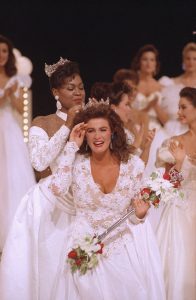
Miss America of 1992, Carolyn Suzanne Sapp of Hawaii, is crowned by former Miss America Marjorie Judith Vincent during the finals of the Miss America Pageant at the Convention Hall in Atlantic City, N.J., Sept. 14, 1991. (AP Photo/Charles Rex Arbogast)
older, it’s hard to get that back,” she said. “If you don’t have young women competing as teenagers, who decide they want to compete in college, you just lose a lot of your momentum. And I guess what I’ve seen is that it just doesn’t have the brand recognition, the excitement that it used to. And a lot of people think, the feminist movement killed Miss America. I don’t think that’s what happened.
“If you read my book, I think the feminist movement in unexpected ways gave Miss America new energy throughout the ‘70s and ‘80s and even into the ‘90s,” she said. “Ultimately. I think Miss America came up against reality TV. So much of what we enjoy about reality programming that we started seeing in 2000-2001, a lot of those elements of competition of real people off of these moments of unscripted emotion, the Miss America pageant offered that on television starting in 1954, and it was pretty addictive. The problem is, that you had new TV shows coming along 20 years ago that improved upon that formula and really not just stole right from Miss America, but our cultural attention from Miss America. It created this huge class of unfamous famous people.
“Miss America used to be this one unfamous young woman who was suddenly famous,” Argetsinger added. “Now our culture has so many people, thanks to reality TV and thanks increasingly to social media. They’re just so many other platforms out there to capture our attention in the ways Miss America used to, and which do it more efficiently.”
“You have to look at what role did Miss America used to play in our culture? She used to play a pretty unique role and it’s just not that anymore,” she said, noting after the very first winner – 1921’s Margaret Gorman – her

(From left) Bill Kurtis and Phyllis George on the set of The CBS Morning News. Image dated December 4, 1984. (Photo by CBS via Getty Images)
hometown of Washington also hasn’t seen much respect from Miss America. The only other District of Columbia Miss America was Venus Ramey in 1944.
“The Miss D.C. pageants went dormant for about 20 years. And I think it really just kind of regained its strength in the ‘90s,” Argetsinger said. “D.C. doesn’t get a whole lot of respect because it’s, of course, it’s just a city. It doesn’t have that many competitors.”
Her favorite winner was Phyllis George (1971), who went onto a famous career with CBS Sports. Argetsinger first met her in October 2018, when she started working on the book, and kept in touch until George’s death in May 2020, at 70 from a blood cancer. “She went on to have a groundbreaking career. She became a sportscaster star of CBS’s ‘The NFL Today.’ She was really one of the first women to break that glass ceiling in sports broadcasting,” she said. “Obviously, she inspired a lot of other Miss America types to go into TV anchoring. We see them all over the place now, but she was a force for women in general. She later became the first lady of Kentucky, just a dazzling, high-energy personality. Her career in broadcasting had a lot of ups and downs. She’s an example of someone who got promoted too far too fast. And the TV business is not kind, does not give a lot of second chances to people, but she’s really just a bubbly, charismatic woman with great people skills. Just fascinating to talk to, and incredibly likable.”
The cover image for “There She Was” is of a Miss America not even mentioned in the book — Rose Coyle, from the 1930s. Argetsinger said she wanted the book to focus on the second half of Miss America’s history, since the story of its early years had already been told a lot.
“I found the story of the pageants survival since the 1960s, since feminism, to be the extraordinary story,” she said. “So at first, I was surprised when Simon & Schuster suggested this as the cover. As we looked at many options, there is just something captivating about this image and almost kind of timeless, something that spoke to the kind of larger vague ideal of Miss America as this iconic woman, sitting on a

(Original Caption) Lee Ann Meriwether, the 19 year old San Francisco girl who became reigning queen of American beauties last night amid a torrent of joyous tears, changed her tune this morning and shows how it feels to be a queen. With scepter in hand, Lee Ann kicks her heels in the surf at Atlantic City the morning after the biggest night of her life. She said she will use the scholarship to train for an acting career.
throne and a lot of people have said things about that cover – that it really catches their attention and it evokes a certain mood.”
Argetsinger is unsure what the future holds for Miss America, which still doesn’t have a network for broadcast in December 2021, of its 100th anniversary year. “We are definitely no longer in the days where the networks competed to try to put Miss America on the air,” she said. “It used to be networks would pay millions of dollars for the right to attach themselves to Miss America, but in several recent years, Miss America actually had to pay a network in order to get the air time, and as you can imagine that’s a very difficult business model to sustain. At the end of the day, they have to make the money somehow and it used to be by and large from television. And from sponsors who have frankly lost interest.”
“Following the success of the Miss America 2020 competition at Mohegan Sun, we knew we had created something very special here in Connecticut and we’re thrilled to be able to host Miss America events and competitions for the next three years at our destination,” Jeff Hamilton, president and general manager of Mohegan Sun, said in a April 2021 release.
“Miss America will now become one of Mohegan Sun’s largest annual events in terms of size, scope, and reach, allowing us to continue to deliver world-class, unique experiences to all those who step through our doors. We share many values with MAO, such as community support and empowerment, and we are excited and honored to add the like-minded organization to our incredible roster of renowned partners.”
The centennial milestone competition will continue to highlight a diverse group of young students and professionals who are advancing the message of female strength, independence, and empowerment through their efforts in the areas of scholarship, talent, and social impact, according to Miss America.
“For 100 years Miss America has been an icon, a champion for social causes, and one of the leading providers of scholarships to women in the country,” said Shantel Krebs, Miss America Organization president & CEO. “We are thrilled to have Mohegan Sun join us in this mission. Their dedication to excellence and state-of-the-art facilities make them the ideal partner as we enter into our second century of service to America’s outstanding young women.“
For more information, visit www.missamerica.org. For more on the author of “There She Was,” visit amyargetsinger.com. Argetsinger and her husband, who works in strategic communications, have a seven-year-old daughter, Eliza. You can buy the book (hardcover for $28) HERE.











